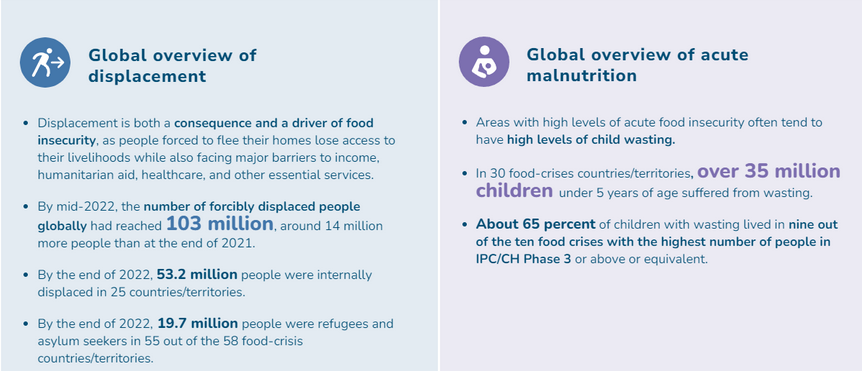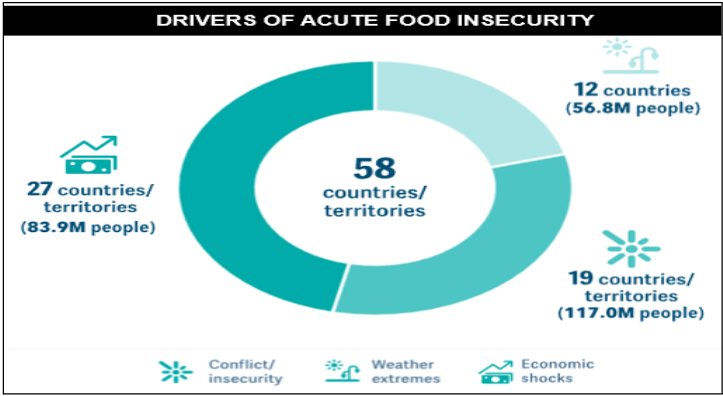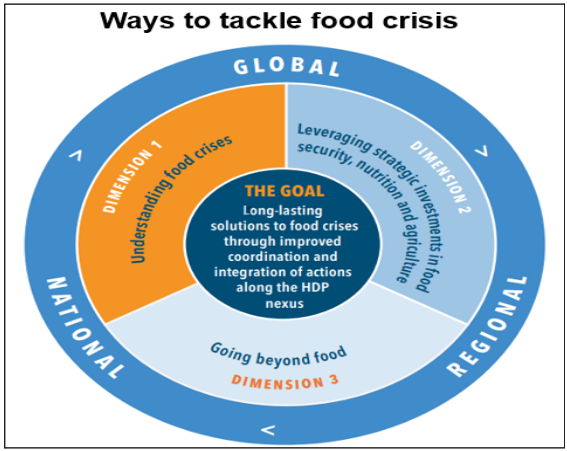GS Paper I
News Excerpt:
According to the UN agencies and development groups, Food insecurity worsened around the world in 2023.
Key Points:
- With some 282 million people suffering from acute hunger due to conflicts, particularly in Gaza and Sudan.
- Extreme weather events and economic shocks also added to the number of those facing acute food insecurity, which grew by 24 million people compared with 2022, according to the latest Global report on food crises from the Food Security Information Network (FSIN).
- 2023 was the fifth consecutive year of rises in the number of people suffering acute food insecurity, defined as when populations face food deprivation that threatens lives or livelihoods, regardless of the causes or length of time.
- Much of last year's increase was due to the report's expanded geographic coverage, as well as deteriorating conditions in 12 countries.
- More geographical areas experienced "new or intensified shocks" while there was a "marked deterioration in key food crisis contexts such as Sudan and the Gaza Strip".
- Some 700,000 people, including 600,000 in Gaza, were on the brink of starvation last year, a figure that has since climbed yet higher to 1.1 million in the war-ridden Palestinian territory.
- On a positive note, the situation improved in 17 countries in 2023, including the Democratic Republic of Congo and Ukraine, the report found.

Children starving:
- Since the first report by the Global Food Crisis Network covering 2016, the number of food-insecure people has risen from 108 million to 282 million.
- Meanwhile, the share of the population affected within the areas concerned has doubled, from 11 percent to 22 percent.
- Protracted major food crises are ongoing in Afghanistan, the Democratic Republic of Congo, Ethiopia, Nigeria, Syria and Yemen.
- War, climate chaos and a cost-of-living crisis, combined with inadequate action, mean that almost 300 million people faced acute food crisis in 2023.
- One of the reasons is that Funding is not keeping pace with need.
- This is especially true as the costs of distributing aid have risen.
- For 2024, progress will depend on the end of hostilities, who stressed that aid could "rapidly" alleviate the crisis in Gaza or Sudan, for example, once humanitarian access to the areas is possible.
|
Food Security Information Network
|
Drivers of food insecurity
- Conflict/insecurity
-
- This includes interstate and intra-state conflicts, internal violence, banditry and criminality, civil unrest or political crises often leading to population displacements and/or disruption of livelihoods and food systems.
- It is a key driver of acute food insecurity because in conflict situations civilians are frequently deprived of their income sources and or have difficulties in accessing food as food systems and markets are disrupted, pushing up food prices and sometimes leading to scarcities of water and fuel, or of food itself.
- Worsening conditions in Haiti were due to political instability and reduced agricultural production, "where in the breadbasket of the Artibonite Valley, armed groups have seized agricultural land and stolen crops".
- According to the report, situations of conflict or insecurity have become the main cause of acute hunger in 20 countries or territories, where 135 million people have suffered.
- Weather extremes
-
- These include droughts, floods, dry spells, storms, cyclones, hurricanes, typhoons and the untimely start of rainy seasons.
- Weather extremes drive food insecurity by directly affecting crops and/or livestock, cutting off roads and preventing markets from being stocked.
- Poor harvests push up food prices and diminish agricultural employment opportunities and pastoralists' terms-of trade, lowering purchasing power and access to food, and triggering an early lean season when households are more market-reliant because of reduced food stocks.
- The El Nino weather phenomenon could also lead to severe drought in West and Southern Africa.
- Extreme climatic events such as floods or droughts were the main cause of acute food insecurity for 72 million people in 18 countries, while economic shocks pushed 75 million people into this situation in 21 countries.

- Economic shocks
-
- Economic shocks at the country level can affect the food insecurity of households or individuals through various channels.
- Macroeconomic shocks may lead to increases in acute food insecurity through for instance, a contraction in GDP leading to high unemployment rates and consequent loss of income for those affected households, or a significant contraction in exports and/ or a critical decrease in investments and other capital inflows, bringing a significant currency depreciation and high inflation, increasing production costs and food prices and worsening terms of trade which may lead to increases in acute food insecurity.
- High debt and limited fiscal space constrain economic growth, increase vulnerability to economic shocks and detract from development spending.
- According to the report, Decreasing global food prices did not transmit to low-income, import-dependent countries.
- At the same time, high debt levels "limited government options to mitigate the effects of high prices.
- Disease outbreaks
-
- Disease outbreaks (occurrence of disease cases in excess of normal expectancy) are usually caused by an infection, transmitted through person-to-person contact, animal -person contact, or from the environment or other media.
- Water, sanitation, food and air quality are vital elements in the transmission of communicable diseases and in the spread of diseases prone to cause epidemics.
- Crop pests and animal diseases
-
- Transboundary plant pests and diseases can easily spread to several countries and reach epidemic proportions.
- Outbreaks and upsurges can cause huge losses to crops and pastures, threatening the livelihoods of vulnerable farmers and the food and nutrition security of millions at a time.
- All animal diseases have the potential to adversely affect human populations by reducing the quantity and quality of food, other livestock products (hides, skins, fibres) and animal power (traction, transport) that can be obtained from a given quantity of resources and by reducing people's assets.
- Transboundary plant pests and diseases can easily spread to several countries and reach epidemic proportions.

